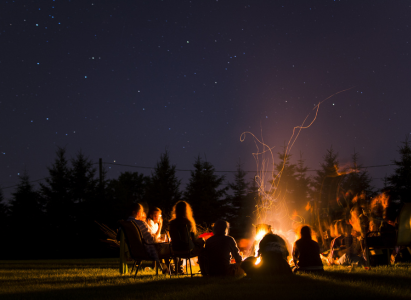Lighting Your Campfire
Depending on how well you've planned ahead or how scarce your supplies are, there's a few different ways available for you to light your campfire.
Matches
Matches are useful as they're inexpensive and you can throw them straight into your tinder. They'll also burn up themselves and serve as a tiny bit of kindling.
Lighters
Using a cigarette or candle lighter, it's best practice to light the tip of a thin stick and insert it into the tinder, rather than putting the lighter directly towards it. This is just on the off-chance that there is any excess lighter fluid on the outside that could accidentally act as an accelerant. You can also use some weatherproof fire starters, so if you're learning in advance rather than out in the field right now, you've got time to grab some!
How To Light A Fire Using Sticks
For that traditional survivalist experience, you may want to have a go at lighting your campfire using sticks. It's much more long winded than other methods of lighting campfires, but it's a rewarding experience creating a fire entirely from scratch.
In order to light your fire using only sticks, you'll first have to find a sturdy, dry log that can be chopped and shaved down to create a fireboard. A fireboard is essentially a small, flat piece of wood with some holes shaped inside of it, which are used to place the sticks you'll use to twist and create friction.
Once you've got your fireboard, find a dry medium length stick that's strong enough to not snap under a bit of light pressure. Shave down the bark with a knife or sharp stone all the way around the stick.
Next, place the stick upright inside the tightest fitting hole in your fireboard and position the stick between the palms of both of your hands.
Begin rolling the stick within your palms, making sure to apply some pressure downwards as you roll. Once you've got a rhythm going, you should begin to see tiny embers and smoke appear from the base, in which case it's now time to speed up the rolling, as there's almost enough friction to ignite the fire.
Cleaning Up Your Campfire
Once you're finished with your campfire, it's time to put it out. In order to do this, you'll be needing some water. A bucket is useful, but they're not always brought along on camping trips so you may have to settle for your camping flask. Fill up your container with water and pour it generously over the base of the fire. As you pour the water, grab a nearby stick and begin stirring the base of the fire in order to wet the entirety of the ashes and put out any remaining embers. It can take roughly 15 minutes to put a fire out entirely.
Remember: Leave No Trace
The outdoors is for everyone, so it's only fair that you clean up after you've finished in order for the next group to enjoy themselves. That means keeping in mind some of the princples of leave no trace.
Once your ashes have safely cooled down (you can check this by placing the back of your hand slightly above the pile), scatter the ashes in various places nearby so that the ground looks relatively undisturbed. Make sure you don't leave any litter either!
Find this article useful?
If you liked this post, be sure to check out some of our other great camping content, including camping recipes, how-to's and other bits of family fun.

